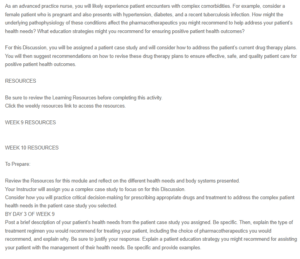Discussion – Women’s and Men’s Health, Infectious Disease, and Hematologic Disorders
Responding to Leasa
Hello Leasa,
Great post! I appreciate your comprehensive analysis of the patient case, particularly in outlining the rationale behind the antibiotic therapy for community-acquired pneumonia (CAP). Your choice of ceftriaxone and azithromycin aligns with current recommendations, emphasizing their efficacy against common pathogens. I would like to add that considering the patient’s comorbidities, especially diabetes, it’s crucial to monitor glycemic control during treatment (Rosenthal & Burchum, 2021). Ceftriaxone may influence glucose levels, necessitating vigilant glucose monitoring and potential adjustments in the patient’s diabetic management plan.
Moreover, your emphasis on patient education is commendable. In addition to vaccination and smoking cessation, highlighting the importance of regular glucose monitoring and adherence to prescribed medications for diabetes management would empower the patient to actively participate in their overall health (Laffel et al., 2020). Furthermore, given the reported nausea and vomiting, incorporating dietary modifications, such as small, frequent meals and hydration strategies, alongside the suggested antiemetic, could enhance patient comfort and adherence to the treatment plan. Overall, your insights contribute significantly to the patient-centered approach to managing complex cases.
References
Laffel, L. M., Kanapka, L. G., Beck, R. W., Bergamo, K., Clements, M. A., Criego, A., DeSalvo, D. J., Goland, R., Hood, K., Liljenquist, D., Messer, L. H., Monzavi, R., Mouse, T. J., Prahalad, P., Sherr, J., Simmons, J. H., Wadwa, R. P., Weinstock, R. S., Willi, S. M., & Miller, K. M. (2020). Effect of continuous glucose monitoring on glycemic control in adolescents and young adults with type 1 diabetes. JAMA, 323(23), 2388. https://doi.org/10.1001/jama.2020.6940
Rosenthal, L.D., & Burchum, J. R. (2021). Lehne’s pharmacotherapeutics for Advanced Practice Nurses (2nd ed.). St. Louis, MO: Elsevier
Responding to Ivonne
Hello Ivonne,
Great post! You provided a comprehensive analysis of the patient case study, addressing the complex health needs effectively. Your emphasis on prioritizing oxygen requirements and managing COPD in the context of community-acquired pneumonia is well-founded. I appreciate your consideration of alternative antibiotics, given the patient’s penicillin allergy, aligning with the principles of personalized medicine (Rosenthal & Burchum, 2021). Your discussion on nutritional therapy and the potential need for parenteral nutrition demonstrates a holistic approach to patient care. However, I would like to add that considering the patient’s history of hypertension and diabetes, monitoring blood glucose levels becomes crucial during treatment. Integrating a collaborative approach with the nutrition team for a comprehensive assessment of nutritional needs is commendable. In the patient education strategy, emphasizing the importance of regular follow-up with the primary care physician for better outcomes is vital. Additionally, discussing potential drug interactions with antidiabetic medications and antibiotics could enhance the patient’s understanding (Tuladhar et al., 2021). Overall, your response is insightful, incorporating various dimensions of care.
References
Tuladhar, L. R., Shrestha, S. L., Bimali, S., Bhusal, S., & Khadka, P. (2021). Drug-drug interactions between hypoglycemic and non-hypoglycemic medication in diabetic patients with comorbidities in a tertiary care center: A descriptive cross-sectional study. Journal of Nepal Medical Association, 59(243), 1125–1130. https://doi.org/10.31729/jnma.7080
Rosenthal, L.D., & Burchum, J. R. (2021). Lehne’s pharmacotherapeutics for advanced practice nurses (2nd ed.). Elsevier.
ORDER A PLAGIARISM-FREE PAPER HERE
We’ll write everything from scratch
Question
As an advanced practice nurse, you will likely experience patient encounters with complex comorbidities. For example, consider a female patient who is pregnant and also presents with hypertension, diabetes, and a recent tuberculosis infection. How might the underlying pathophysiology of these conditions affect the pharmacotherapeutics you might recommend to help address your patient’s health needs? What education strategies might you recommend for ensuring positive patient health outcomes?

Women’s and Men’s Health, Infectious Disease, and Hematologic Disorders
For this Discussion, you will be assigned a patient case study and will consider how to address the patient’s current drug therapy plans. You will then suggest recommendations on how to revise these drug therapy plans to ensure effective, safe, and quality patient care for positive patient health outcomes.
RESOURCES
Be sure to review the Learning Resources before completing this activity.
Click the weekly resources link to access the resources.
WEEK 9 RESOURCES
WEEK 10 RESOURCES
To Prepare:
Review the Resources for this module and reflect on the different health needs and body systems presented.
Your Instructor will assign you a complex case study to focus on for this Discussion.
Consider how you will practice critical decision-making for prescribing appropriate drugs and treatment to address the complex patient health needs in the patient case study you selected.
BY DAY 3 OF WEEK 9
Post a brief description of your patient’s health needs from the patient case study you assigned. Be specific. Then, explain the type of treatment regimen you would recommend for treating your patient, including the choice of pharmacotherapeutics you would recommend, and explain why. Be sure to justify your response. Explain a patient education strategy you might recommend for assisting your patient with the management of their health needs. Be specific and provide examples.
You will respond to your colleagues’ posts in Week 10.
Note: For this Discussion, you are required to complete your initial post before you will be able to view and respond to your colleagues’ postings. Begin by clicking on the Reply button to complete your initial post. Remember, once you click on Post Reply, you cannot delete or edit your own posts and you cannot post anonymously. Please check your post carefully before clicking on Post Reply!
BY DAY 6 OF WEEK 10
Read a selection of your colleagues’ responses from Week 9 and respond to at least two of your colleagues on two different days who were assigned a different patient case study, and provide recommendations for alternative drug treatments to address the patient’s pathophysiology. Be specific and provide examples.

